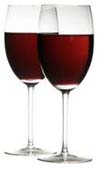After a slew of studies evidencing an increased probability of women getting breast cancer with higher consumption of wine comes a study published online in the Journal of Women's Health, challenging the widely-held belief that all types of alcohol consumption heighten the risk of developing breast cancer.
 A study conducted by Cedars-Sinai Hospital in Los Angeles has found that chemicals in the skins and seeds of red grapes slightly lowered estrogen levels while elevating testosterone among premenopausal women who drank eight ounces (about 250 mL- or a third of a standard sized bottle) of red wine nightly for about a month. A study conducted by Cedars-Sinai Hospital in Los Angeles has found that chemicals in the skins and seeds of red grapes slightly lowered estrogen levels while elevating testosterone among premenopausal women who drank eight ounces (about 250 mL- or a third of a standard sized bottle) of red wine nightly for about a month.
Interestingly, white wine lacked the same effect, according to the report published yesterday by Medical Express. Co-author Glenn D. Braunstein, MD, said the results do not mean that white wine increases the risk of breast cancer but that grapes used in those varieties may lack the same protective elements found in reds.
"There are chemicals in red grape skin and red grape seeds that are not found in white grapes that may decrease breast cancer risk," said Braunstein, vice president for Clinical Innovation and the James R. Klinenberg, MD, Chair in Medicine.
In the Cedars-Sinai study, 36 women were randomized to drink either Cabernet Sauvignon or Chardonnay daily for almost a month, then switched to the other type of wine. Blood was collected twice each month to measure hormone levels.
Investigators said the change in hormone patterns suggested that red wine may stem the growth of cancer cells, as has been shown in test tube studies.
Researchers called their findings encouraging, saying women who occasionally drink alcohol might want to reassess their choices. "If you were to have a glass of wine with dinner, you may want to consider a glass of red," said Chrisandra Shufelt, MD, assistant director of the Women's Heart Center at the Cedars-Sinai Heart Institute and one of the study's co-authors. "Switching may shift your risk."
Breast cancer is the leading type of women's cancer in the U.S., accounting for more than 230,000 new cases last year, or 30 % of all female cancer diagnoses. An estimated 39,000 women died from the disease in 2011, according to the American Cancer Society.
Doctors long have determined that alcohol increases the body's estrogen levels, fostering the growth of cancer cells. In fact, a few of the recent studies have indicated that the risk starts with the first sip of alcohol and gets accelerated with more alcohol including wine.
It has been generally recommended by doctors that the women should restrict their wine intake to a glass a day whereas men are advised two glasses of red. Boston-based Dr. Curt Ellison, an epidemiologist and a panelist of the International Scientific Forum on Alcohol Research has headed several studies on wine and health during the last two decades. He agrees that there is a 10% increased probability of breast cancer with one glass of wine which appears to get neutralized if women take a daily dosage of inexpensive folate pills, which are folic acid in the form of pills. Folates are water-soluble B vitamin that occur naturally in food-especially leafy vegetables.
Although the report does not indicate whether the studies was conducted independently or was financed by a wine group, it would be relief to many women who might have developed a fear psychosis after several studies during the last couple of years asserting that wine or any alcohol was positively harmful for women in any quantity and increased the chance of cancer. These studies had nevertheless, stayed away from studying the overall mortality rate which is lowered since wine is known to have a positive impact on the health of heart which becomes more menacing for women after they turn around fifty.
While delWine finds the study encouraging, we would still like to recommend a middle-of-the-road approach which we have been doing for a decade- that women should drink a glass of red wine a day (125 mL) while men may have two (average alcohol 12.5%)-adjusting the amount proportionately downwards, for higher alcohol. For the more adventurous, the limit could be increased to two and three glasses respectively. Medical advice from your evolved physician is advised in case of uncertainty- editor
|